A Study on Sleep Quality and Educational Performance in Saudi Arabia
VerifiedAdded on 2023/04/21
|14
|3471
|298
Report
AI Summary
This report investigates the significant impact of sleep quality on the educational performance of college students in Saudi Arabia. The study highlights that inadequate sleep patterns and sleep deprivation are prevalent among university students in Saudi Arabia, leading to decreased academic performance, increased daytime sleepiness, and various health issues. The research explores the correlation between sleep quality and academic outcomes, revealing that poor sleep negatively affects students' ability to concentrate, make decisions, and attend classes. The report also examines the methodology used, including survey and interview-based qualitative research, to gather data from a sample of university students. It further discusses the reasons behind the chosen research approach, sample selection, and data collection methods, including mixed research design with both qualitative and quantitative methods. The findings underscore the need for increased awareness among students about the importance of quality sleep to enhance their academic and overall well-being. The study concludes that poor sleep quality directly affects academic performance.
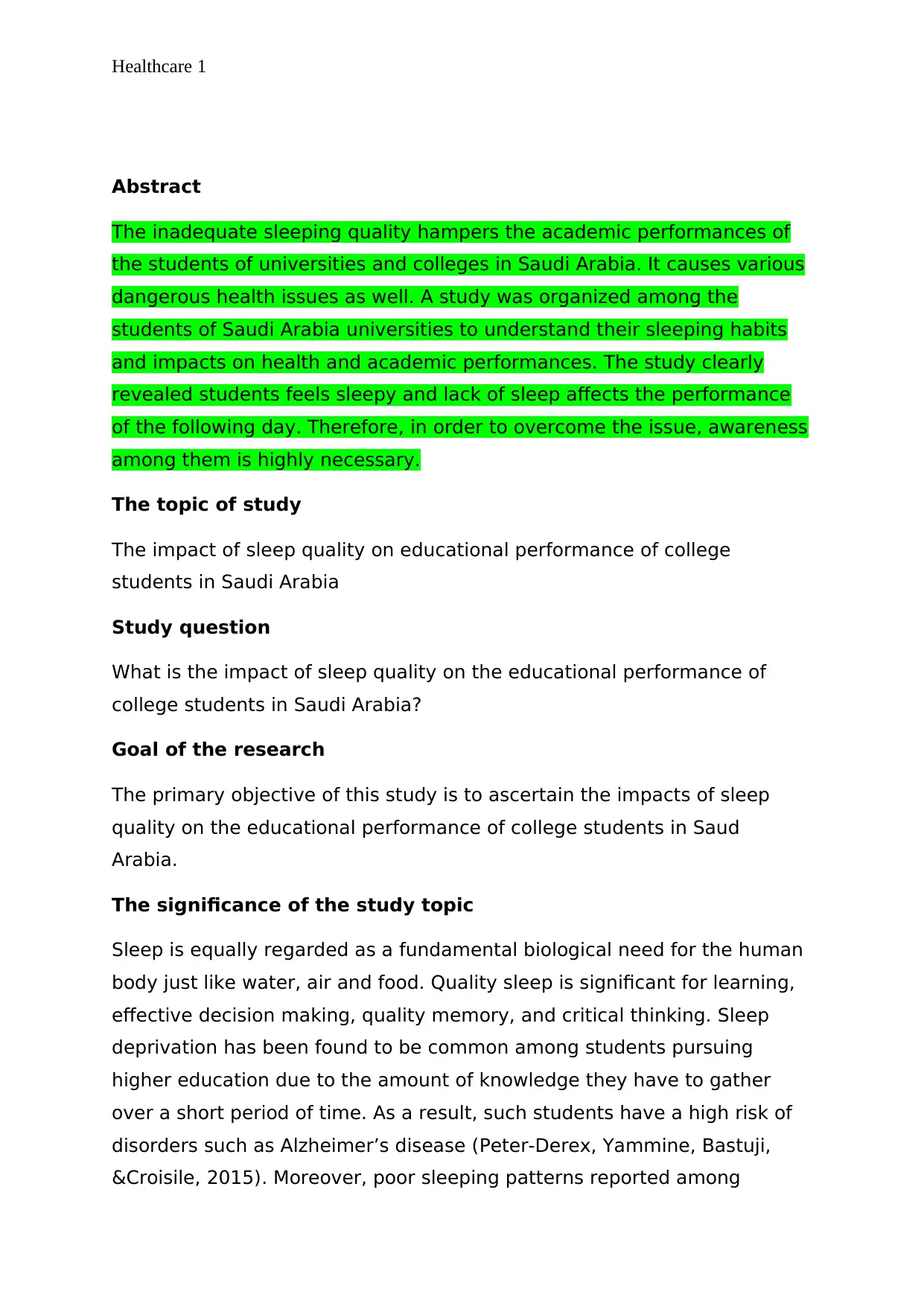
Healthcare 1
Abstract
The inadequate sleeping quality hampers the academic performances of
the students of universities and colleges in Saudi Arabia. It causes various
dangerous health issues as well. A study was organized among the
students of Saudi Arabia universities to understand their sleeping habits
and impacts on health and academic performances. The study clearly
revealed students feels sleepy and lack of sleep affects the performance
of the following day. Therefore, in order to overcome the issue, awareness
among them is highly necessary.
The topic of study
The impact of sleep quality on educational performance of college
students in Saudi Arabia
Study question
What is the impact of sleep quality on the educational performance of
college students in Saudi Arabia?
Goal of the research
The primary objective of this study is to ascertain the impacts of sleep
quality on the educational performance of college students in Saud
Arabia.
The significance of the study topic
Sleep is equally regarded as a fundamental biological need for the human
body just like water, air and food. Quality sleep is significant for learning,
effective decision making, quality memory, and critical thinking. Sleep
deprivation has been found to be common among students pursuing
higher education due to the amount of knowledge they have to gather
over a short period of time. As a result, such students have a high risk of
disorders such as Alzheimer’s disease (Peter-Derex, Yammine, Bastuji,
&Croisile, 2015). Moreover, poor sleeping patterns reported among
Abstract
The inadequate sleeping quality hampers the academic performances of
the students of universities and colleges in Saudi Arabia. It causes various
dangerous health issues as well. A study was organized among the
students of Saudi Arabia universities to understand their sleeping habits
and impacts on health and academic performances. The study clearly
revealed students feels sleepy and lack of sleep affects the performance
of the following day. Therefore, in order to overcome the issue, awareness
among them is highly necessary.
The topic of study
The impact of sleep quality on educational performance of college
students in Saudi Arabia
Study question
What is the impact of sleep quality on the educational performance of
college students in Saudi Arabia?
Goal of the research
The primary objective of this study is to ascertain the impacts of sleep
quality on the educational performance of college students in Saud
Arabia.
The significance of the study topic
Sleep is equally regarded as a fundamental biological need for the human
body just like water, air and food. Quality sleep is significant for learning,
effective decision making, quality memory, and critical thinking. Sleep
deprivation has been found to be common among students pursuing
higher education due to the amount of knowledge they have to gather
over a short period of time. As a result, such students have a high risk of
disorders such as Alzheimer’s disease (Peter-Derex, Yammine, Bastuji,
&Croisile, 2015). Moreover, poor sleeping patterns reported among
Paraphrase This Document
Need a fresh take? Get an instant paraphrase of this document with our AI Paraphraser

Healthcare 2
university students’ causes sleepiness and leads to low emotional,
cognitive, behavioural and academic performance.
Scopes in health
Incidence of poor sleep quality among learners in higher
education
Approximately 70% of university students in Saudi Arabia have poor sleep
quality patterns, with 37% experiencing Excessive Daytime Sleepiness
(EDS). The world statistics show that over 50% have poor sleeping
patterns (Ibrahim, Badawi, Mansouri, Ainousa, & Jambi, 2017).
Increased risk for poor academic performance, stress, and drug
abuse
Poor sleep quality among students in higher education due to the
magnitude of the content of the study leads to poor academic
performance. This can be attributed to excessive daytime sleepiness and
lecture absenteeism. Students that smoke is likely to experience poor
sleep quality.
Introduction
Sleep is very significant in the health of human beings. Loss of sleep or
poor sleep patterns facilitates the risk for other health complications such
as Alzheimer’s disease (Peter-Derex, et al., 2015). Experts in sleep
recommend eight hours sleep daytime. However, due to the increasing
content of university education to meet the needs of a dynamic society,
students have to cope-up with it by depriving themselves of sleep. Sleep
deprivation among students has been attributed to poor attention,
memory and lack of critical thinking which affects their overall academic
performance. It is very important to have a proper sleep in order to
maintain the restorative and reparative bodily function of the human body
(Mahfouz et al., 2014). The quality of sleep is a serious area of concern for
university students’ causes sleepiness and leads to low emotional,
cognitive, behavioural and academic performance.
Scopes in health
Incidence of poor sleep quality among learners in higher
education
Approximately 70% of university students in Saudi Arabia have poor sleep
quality patterns, with 37% experiencing Excessive Daytime Sleepiness
(EDS). The world statistics show that over 50% have poor sleeping
patterns (Ibrahim, Badawi, Mansouri, Ainousa, & Jambi, 2017).
Increased risk for poor academic performance, stress, and drug
abuse
Poor sleep quality among students in higher education due to the
magnitude of the content of the study leads to poor academic
performance. This can be attributed to excessive daytime sleepiness and
lecture absenteeism. Students that smoke is likely to experience poor
sleep quality.
Introduction
Sleep is very significant in the health of human beings. Loss of sleep or
poor sleep patterns facilitates the risk for other health complications such
as Alzheimer’s disease (Peter-Derex, et al., 2015). Experts in sleep
recommend eight hours sleep daytime. However, due to the increasing
content of university education to meet the needs of a dynamic society,
students have to cope-up with it by depriving themselves of sleep. Sleep
deprivation among students has been attributed to poor attention,
memory and lack of critical thinking which affects their overall academic
performance. It is very important to have a proper sleep in order to
maintain the restorative and reparative bodily function of the human body
(Mahfouz et al., 2014). The quality of sleep is a serious area of concern for

Healthcare 3
the students as in many studies, it is observed that, students have issues
with their sleep. In a study by Hershener&Chervin (2014) suggested that ,
due to sleep deprivation, 50% of the college student has reported day
time sleeping and almost 70% of the total subject population reported
about the insufficient sleep. It can be said that, the impairment in
adequate sleep pattern can cause serious threat to the academic life of
the students and along with this it can serious health consequences such
as depression, risk of obesity (Owens & Adolescent Sleep Working Group,
2014). This discussion will highlight on the impact of sleep deprivation on
the academic performance of the students of Saudi Arabia.
Key terms
Academic Performance, sleep quality
Aims and objectives
The main of the research paper is to find the impact of sleeping quality or
pattern on the academic performances of the participants. At the same
time, it will also find what are the reasons that cause sleeping
disturbances and what are the impacts of those on health.
Review of Literature
Various studies showed that, a poor sleep quality can affect the
academic performance of the students of Saudi Arabia. In a study by Amin
et al. (2015), showed that the poor quality sleep and hampered academic
performance is directly related to each other. In this study, almost 341
students of medical college of Riyadh participated. Among them, majority
of student was male and they were mainly in the third year of their
course. Among the total sample population, 31.6% male students reported
about sleep deprivation and in case of female the number was 29%. It was
the students as in many studies, it is observed that, students have issues
with their sleep. In a study by Hershener&Chervin (2014) suggested that ,
due to sleep deprivation, 50% of the college student has reported day
time sleeping and almost 70% of the total subject population reported
about the insufficient sleep. It can be said that, the impairment in
adequate sleep pattern can cause serious threat to the academic life of
the students and along with this it can serious health consequences such
as depression, risk of obesity (Owens & Adolescent Sleep Working Group,
2014). This discussion will highlight on the impact of sleep deprivation on
the academic performance of the students of Saudi Arabia.
Key terms
Academic Performance, sleep quality
Aims and objectives
The main of the research paper is to find the impact of sleeping quality or
pattern on the academic performances of the participants. At the same
time, it will also find what are the reasons that cause sleeping
disturbances and what are the impacts of those on health.
Review of Literature
Various studies showed that, a poor sleep quality can affect the
academic performance of the students of Saudi Arabia. In a study by Amin
et al. (2015), showed that the poor quality sleep and hampered academic
performance is directly related to each other. In this study, almost 341
students of medical college of Riyadh participated. Among them, majority
of student was male and they were mainly in the third year of their
course. Among the total sample population, 31.6% male students reported
about sleep deprivation and in case of female the number was 29%. It was
⊘ This is a preview!⊘
Do you want full access?
Subscribe today to unlock all pages.

Trusted by 1+ million students worldwide
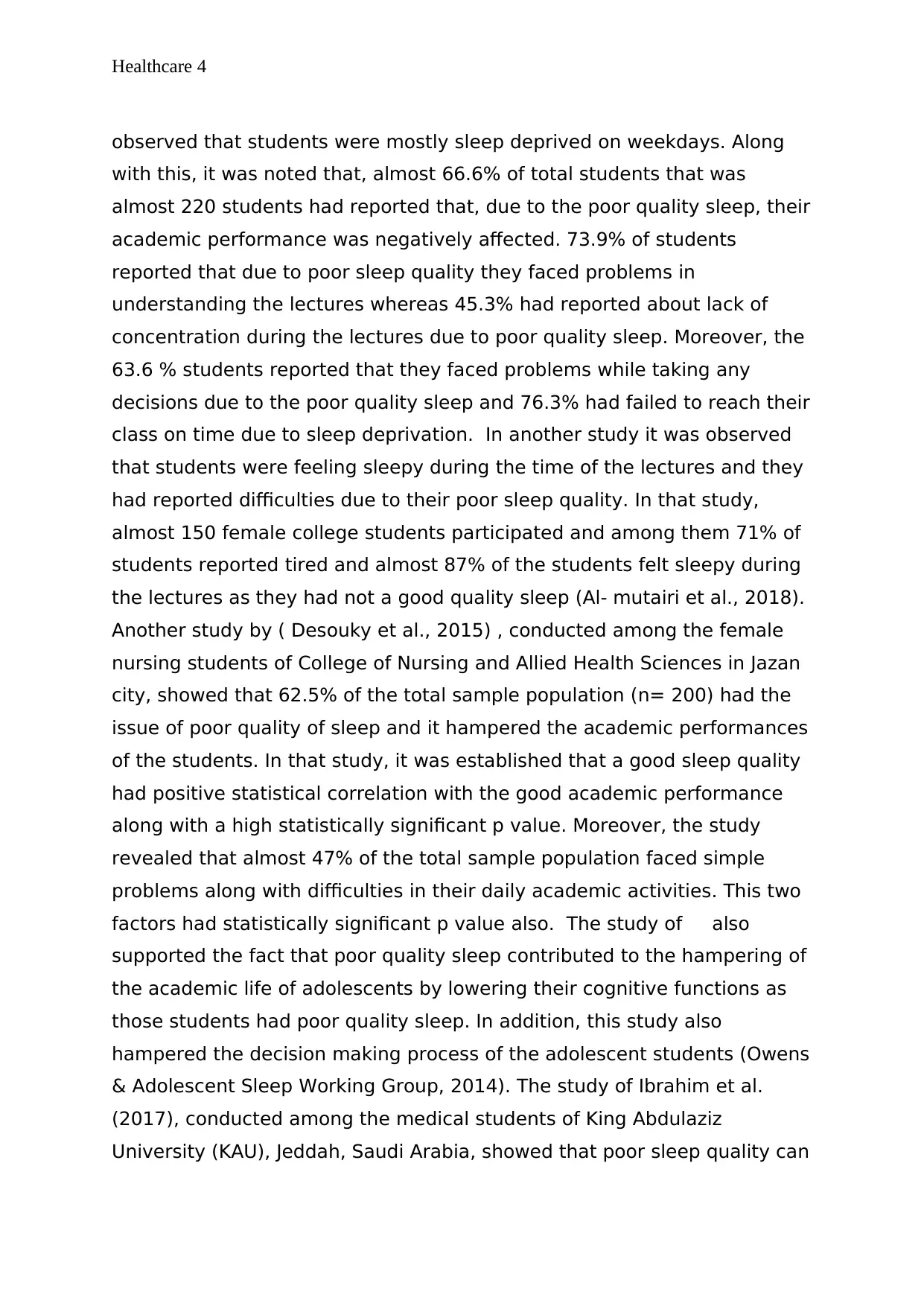
Healthcare 4
observed that students were mostly sleep deprived on weekdays. Along
with this, it was noted that, almost 66.6% of total students that was
almost 220 students had reported that, due to the poor quality sleep, their
academic performance was negatively affected. 73.9% of students
reported that due to poor sleep quality they faced problems in
understanding the lectures whereas 45.3% had reported about lack of
concentration during the lectures due to poor quality sleep. Moreover, the
63.6 % students reported that they faced problems while taking any
decisions due to the poor quality sleep and 76.3% had failed to reach their
class on time due to sleep deprivation. In another study it was observed
that students were feeling sleepy during the time of the lectures and they
had reported difficulties due to their poor sleep quality. In that study,
almost 150 female college students participated and among them 71% of
students reported tired and almost 87% of the students felt sleepy during
the lectures as they had not a good quality sleep (Al- mutairi et al., 2018).
Another study by ( Desouky et al., 2015) , conducted among the female
nursing students of College of Nursing and Allied Health Sciences in Jazan
city, showed that 62.5% of the total sample population (n= 200) had the
issue of poor quality of sleep and it hampered the academic performances
of the students. In that study, it was established that a good sleep quality
had positive statistical correlation with the good academic performance
along with a high statistically significant p value. Moreover, the study
revealed that almost 47% of the total sample population faced simple
problems along with difficulties in their daily academic activities. This two
factors had statistically significant p value also. The study of also
supported the fact that poor quality sleep contributed to the hampering of
the academic life of adolescents by lowering their cognitive functions as
those students had poor quality sleep. In addition, this study also
hampered the decision making process of the adolescent students (Owens
& Adolescent Sleep Working Group, 2014). The study of Ibrahim et al.
(2017), conducted among the medical students of King Abdulaziz
University (KAU), Jeddah, Saudi Arabia, showed that poor sleep quality can
observed that students were mostly sleep deprived on weekdays. Along
with this, it was noted that, almost 66.6% of total students that was
almost 220 students had reported that, due to the poor quality sleep, their
academic performance was negatively affected. 73.9% of students
reported that due to poor sleep quality they faced problems in
understanding the lectures whereas 45.3% had reported about lack of
concentration during the lectures due to poor quality sleep. Moreover, the
63.6 % students reported that they faced problems while taking any
decisions due to the poor quality sleep and 76.3% had failed to reach their
class on time due to sleep deprivation. In another study it was observed
that students were feeling sleepy during the time of the lectures and they
had reported difficulties due to their poor sleep quality. In that study,
almost 150 female college students participated and among them 71% of
students reported tired and almost 87% of the students felt sleepy during
the lectures as they had not a good quality sleep (Al- mutairi et al., 2018).
Another study by ( Desouky et al., 2015) , conducted among the female
nursing students of College of Nursing and Allied Health Sciences in Jazan
city, showed that 62.5% of the total sample population (n= 200) had the
issue of poor quality of sleep and it hampered the academic performances
of the students. In that study, it was established that a good sleep quality
had positive statistical correlation with the good academic performance
along with a high statistically significant p value. Moreover, the study
revealed that almost 47% of the total sample population faced simple
problems along with difficulties in their daily academic activities. This two
factors had statistically significant p value also. The study of also
supported the fact that poor quality sleep contributed to the hampering of
the academic life of adolescents by lowering their cognitive functions as
those students had poor quality sleep. In addition, this study also
hampered the decision making process of the adolescent students (Owens
& Adolescent Sleep Working Group, 2014). The study of Ibrahim et al.
(2017), conducted among the medical students of King Abdulaziz
University (KAU), Jeddah, Saudi Arabia, showed that poor sleep quality can
Paraphrase This Document
Need a fresh take? Get an instant paraphrase of this document with our AI Paraphraser
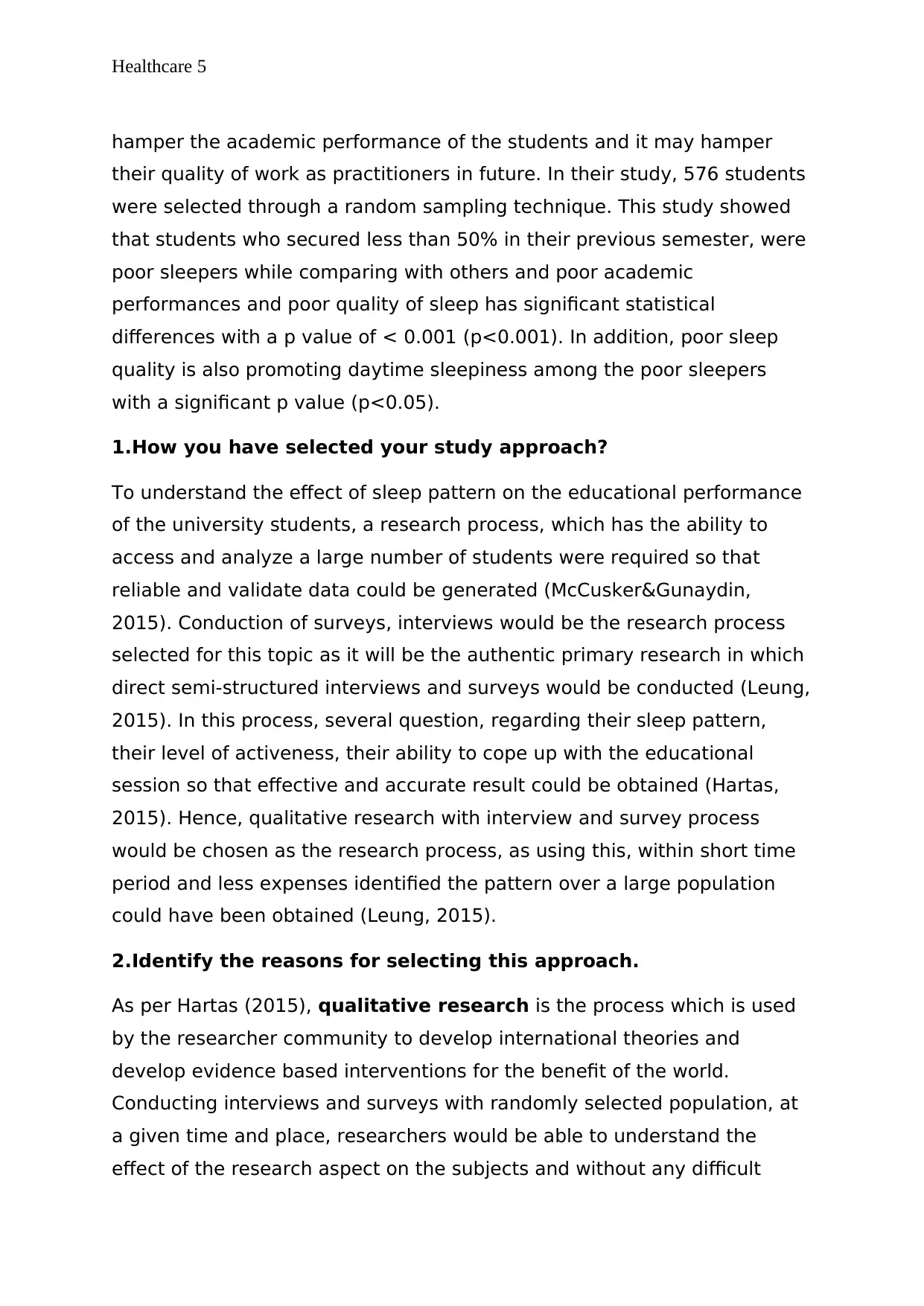
Healthcare 5
hamper the academic performance of the students and it may hamper
their quality of work as practitioners in future. In their study, 576 students
were selected through a random sampling technique. This study showed
that students who secured less than 50% in their previous semester, were
poor sleepers while comparing with others and poor academic
performances and poor quality of sleep has significant statistical
differences with a p value of < 0.001 (p<0.001). In addition, poor sleep
quality is also promoting daytime sleepiness among the poor sleepers
with a significant p value (p<0.05).
1.How you have selected your study approach?
To understand the effect of sleep pattern on the educational performance
of the university students, a research process, which has the ability to
access and analyze a large number of students were required so that
reliable and validate data could be generated (McCusker&Gunaydin,
2015). Conduction of surveys, interviews would be the research process
selected for this topic as it will be the authentic primary research in which
direct semi-structured interviews and surveys would be conducted (Leung,
2015). In this process, several question, regarding their sleep pattern,
their level of activeness, their ability to cope up with the educational
session so that effective and accurate result could be obtained (Hartas,
2015). Hence, qualitative research with interview and survey process
would be chosen as the research process, as using this, within short time
period and less expenses identified the pattern over a large population
could have been obtained (Leung, 2015).
2.Identify the reasons for selecting this approach.
As per Hartas (2015), qualitative research is the process which is used
by the researcher community to develop international theories and
develop evidence based interventions for the benefit of the world.
Conducting interviews and surveys with randomly selected population, at
a given time and place, researchers would be able to understand the
effect of the research aspect on the subjects and without any difficult
hamper the academic performance of the students and it may hamper
their quality of work as practitioners in future. In their study, 576 students
were selected through a random sampling technique. This study showed
that students who secured less than 50% in their previous semester, were
poor sleepers while comparing with others and poor academic
performances and poor quality of sleep has significant statistical
differences with a p value of < 0.001 (p<0.001). In addition, poor sleep
quality is also promoting daytime sleepiness among the poor sleepers
with a significant p value (p<0.05).
1.How you have selected your study approach?
To understand the effect of sleep pattern on the educational performance
of the university students, a research process, which has the ability to
access and analyze a large number of students were required so that
reliable and validate data could be generated (McCusker&Gunaydin,
2015). Conduction of surveys, interviews would be the research process
selected for this topic as it will be the authentic primary research in which
direct semi-structured interviews and surveys would be conducted (Leung,
2015). In this process, several question, regarding their sleep pattern,
their level of activeness, their ability to cope up with the educational
session so that effective and accurate result could be obtained (Hartas,
2015). Hence, qualitative research with interview and survey process
would be chosen as the research process, as using this, within short time
period and less expenses identified the pattern over a large population
could have been obtained (Leung, 2015).
2.Identify the reasons for selecting this approach.
As per Hartas (2015), qualitative research is the process which is used
by the researcher community to develop international theories and
develop evidence based interventions for the benefit of the world.
Conducting interviews and surveys with randomly selected population, at
a given time and place, researchers would be able to understand the
effect of the research aspect on the subjects and without any difficult

Healthcare 6
statistical calculations, effective and accurate data could be obtained
(McCusker&Gunaydin, 2015). Assessing the effect of sleep pattern on the
university student is a global research approach and several researches
have been conducted to find out the effect of this situation on their
educational performance
(Hartas, 2015). Therefore, conduction of interviews and surveys with
university level students within their university campus and assessing
their educational outcomes would be and easy and effective research
approach. Hence, this qualitative research approach with interviews
and surveys would be used to solve the research question (Leung, 2015)
1.Select your study sample
The sample for the study will include university students studying in
management college of Saudi Arabia. It will include students from all
nationality.
2. How have you selected your sample?
The sample group for the study will be recruited by means of simple
random sampling method. The process of recruitment will start by first
screening out students with depression by using DSM-IV manual for
mental disorder. This screening method is essential to exclude any
students with depression and reduce the impact of confounding factors on
research data. After screening out students based on mental illness
screening, the final sample for research will be recruited by random
sampling method. This will involve randomly taking sample from the
remaining students groups and including them after taking informed
consent for research. Simple random sampling is a technique where
selection or recruitment of research participant depends on chance. This
means every student in the university will have equal likelihood of being
selected. The main advantage of using simple random sampling technique
is that small samples can be easily selected from a large sample group.
statistical calculations, effective and accurate data could be obtained
(McCusker&Gunaydin, 2015). Assessing the effect of sleep pattern on the
university student is a global research approach and several researches
have been conducted to find out the effect of this situation on their
educational performance
(Hartas, 2015). Therefore, conduction of interviews and surveys with
university level students within their university campus and assessing
their educational outcomes would be and easy and effective research
approach. Hence, this qualitative research approach with interviews
and surveys would be used to solve the research question (Leung, 2015)
1.Select your study sample
The sample for the study will include university students studying in
management college of Saudi Arabia. It will include students from all
nationality.
2. How have you selected your sample?
The sample group for the study will be recruited by means of simple
random sampling method. The process of recruitment will start by first
screening out students with depression by using DSM-IV manual for
mental disorder. This screening method is essential to exclude any
students with depression and reduce the impact of confounding factors on
research data. After screening out students based on mental illness
screening, the final sample for research will be recruited by random
sampling method. This will involve randomly taking sample from the
remaining students groups and including them after taking informed
consent for research. Simple random sampling is a technique where
selection or recruitment of research participant depends on chance. This
means every student in the university will have equal likelihood of being
selected. The main advantage of using simple random sampling technique
is that small samples can be easily selected from a large sample group.
⊘ This is a preview!⊘
Do you want full access?
Subscribe today to unlock all pages.

Trusted by 1+ million students worldwide
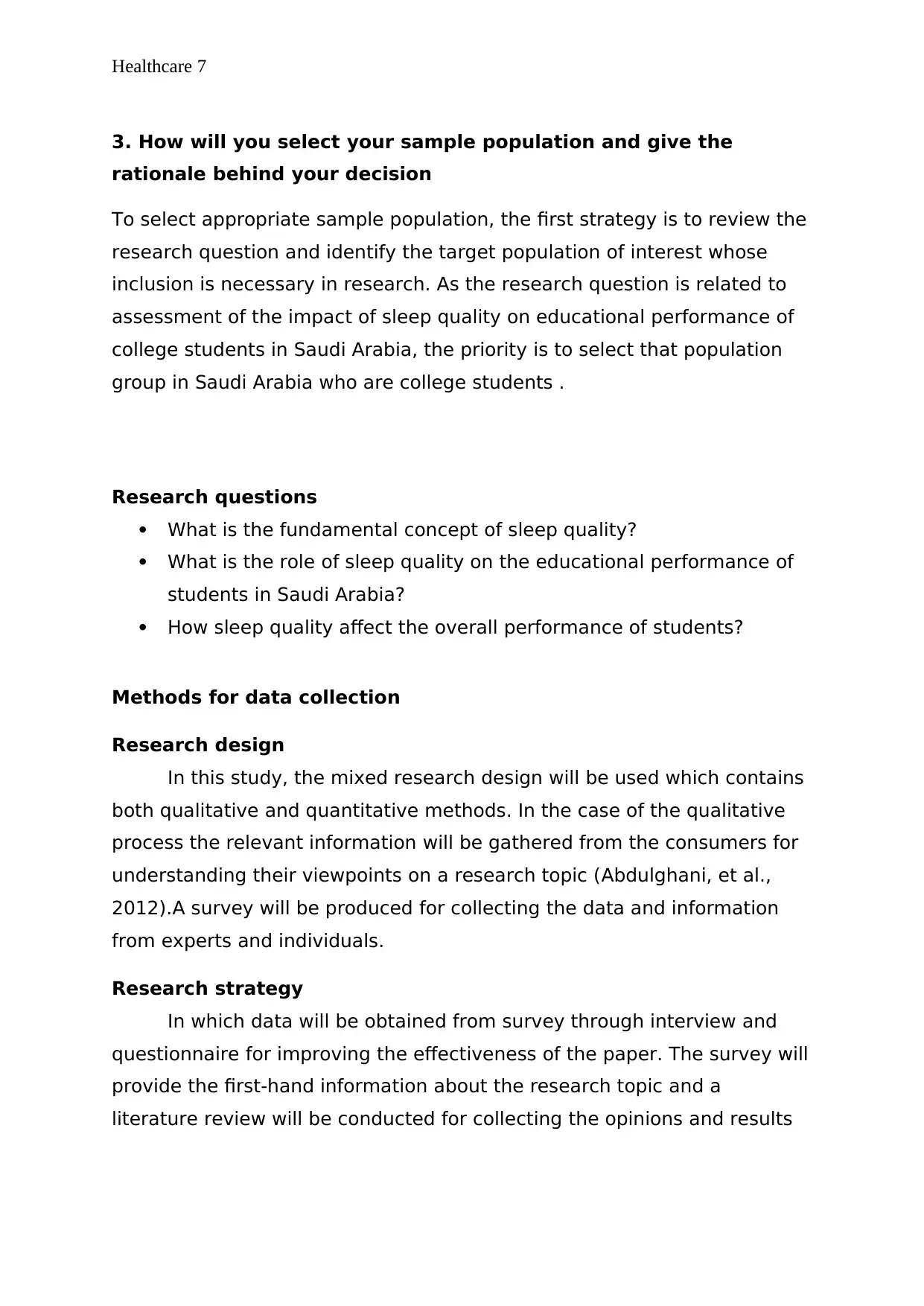
Healthcare 7
3. How will you select your sample population and give the
rationale behind your decision
To select appropriate sample population, the first strategy is to review the
research question and identify the target population of interest whose
inclusion is necessary in research. As the research question is related to
assessment of the impact of sleep quality on educational performance of
college students in Saudi Arabia, the priority is to select that population
group in Saudi Arabia who are college students .
Research questions
What is the fundamental concept of sleep quality?
What is the role of sleep quality on the educational performance of
students in Saudi Arabia?
How sleep quality affect the overall performance of students?
Methods for data collection
Research design
In this study, the mixed research design will be used which contains
both qualitative and quantitative methods. In the case of the qualitative
process the relevant information will be gathered from the consumers for
understanding their viewpoints on a research topic (Abdulghani, et al.,
2012).A survey will be produced for collecting the data and information
from experts and individuals.
Research strategy
In which data will be obtained from survey through interview and
questionnaire for improving the effectiveness of the paper. The survey will
provide the first-hand information about the research topic and a
literature review will be conducted for collecting the opinions and results
3. How will you select your sample population and give the
rationale behind your decision
To select appropriate sample population, the first strategy is to review the
research question and identify the target population of interest whose
inclusion is necessary in research. As the research question is related to
assessment of the impact of sleep quality on educational performance of
college students in Saudi Arabia, the priority is to select that population
group in Saudi Arabia who are college students .
Research questions
What is the fundamental concept of sleep quality?
What is the role of sleep quality on the educational performance of
students in Saudi Arabia?
How sleep quality affect the overall performance of students?
Methods for data collection
Research design
In this study, the mixed research design will be used which contains
both qualitative and quantitative methods. In the case of the qualitative
process the relevant information will be gathered from the consumers for
understanding their viewpoints on a research topic (Abdulghani, et al.,
2012).A survey will be produced for collecting the data and information
from experts and individuals.
Research strategy
In which data will be obtained from survey through interview and
questionnaire for improving the effectiveness of the paper. The survey will
provide the first-hand information about the research topic and a
literature review will be conducted for collecting the opinions and results
Paraphrase This Document
Need a fresh take? Get an instant paraphrase of this document with our AI Paraphraser
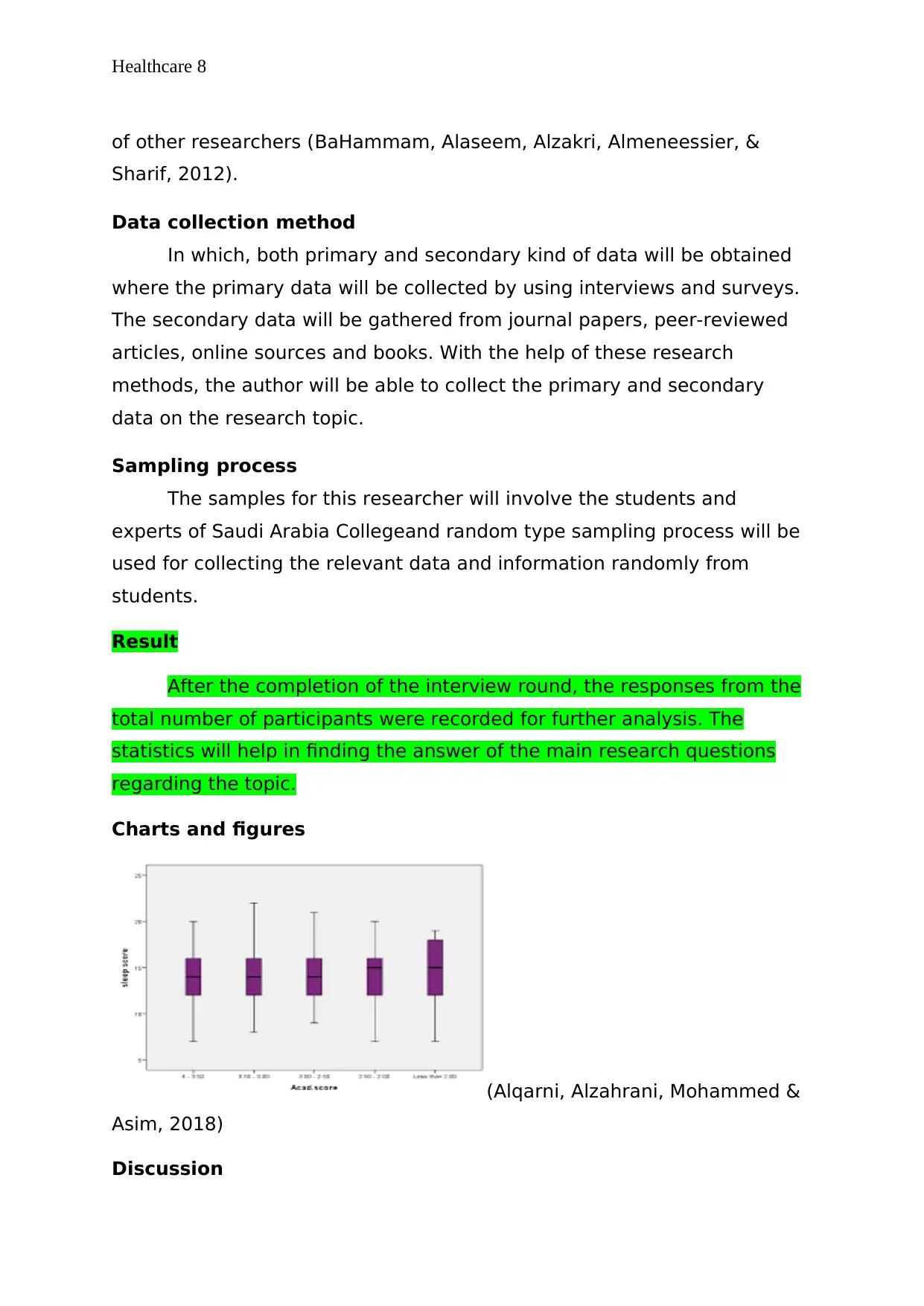
Healthcare 8
of other researchers (BaHammam, Alaseem, Alzakri, Almeneessier, &
Sharif, 2012).
Data collection method
In which, both primary and secondary kind of data will be obtained
where the primary data will be collected by using interviews and surveys.
The secondary data will be gathered from journal papers, peer-reviewed
articles, online sources and books. With the help of these research
methods, the author will be able to collect the primary and secondary
data on the research topic.
Sampling process
The samples for this researcher will involve the students and
experts of Saudi Arabia Collegeand random type sampling process will be
used for collecting the relevant data and information randomly from
students.
Result
After the completion of the interview round, the responses from the
total number of participants were recorded for further analysis. The
statistics will help in finding the answer of the main research questions
regarding the topic.
Charts and figures
(Alqarni, Alzahrani, Mohammed &
Asim, 2018)
Discussion
of other researchers (BaHammam, Alaseem, Alzakri, Almeneessier, &
Sharif, 2012).
Data collection method
In which, both primary and secondary kind of data will be obtained
where the primary data will be collected by using interviews and surveys.
The secondary data will be gathered from journal papers, peer-reviewed
articles, online sources and books. With the help of these research
methods, the author will be able to collect the primary and secondary
data on the research topic.
Sampling process
The samples for this researcher will involve the students and
experts of Saudi Arabia Collegeand random type sampling process will be
used for collecting the relevant data and information randomly from
students.
Result
After the completion of the interview round, the responses from the
total number of participants were recorded for further analysis. The
statistics will help in finding the answer of the main research questions
regarding the topic.
Charts and figures
(Alqarni, Alzahrani, Mohammed &
Asim, 2018)
Discussion
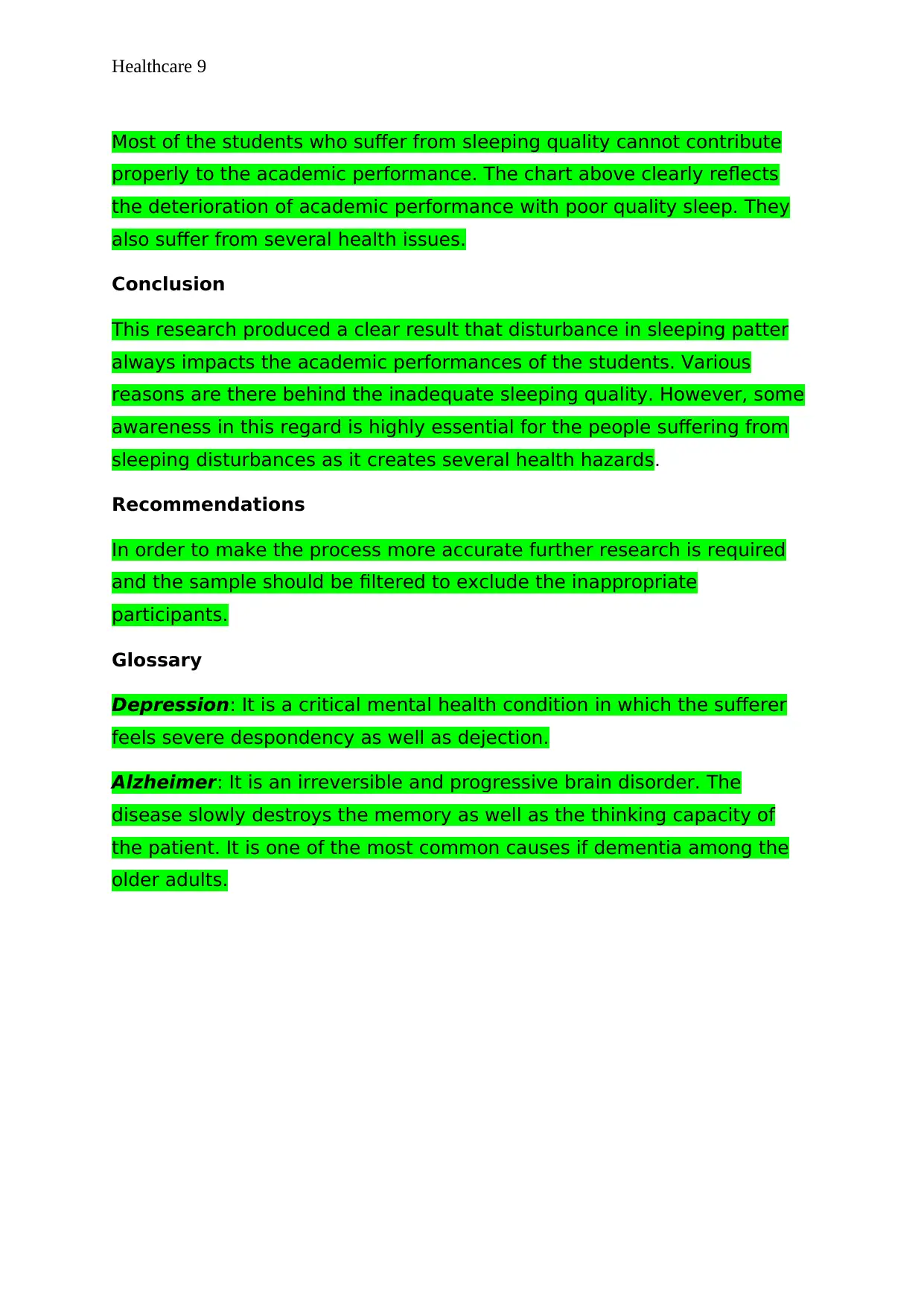
Healthcare 9
Most of the students who suffer from sleeping quality cannot contribute
properly to the academic performance. The chart above clearly reflects
the deterioration of academic performance with poor quality sleep. They
also suffer from several health issues.
Conclusion
This research produced a clear result that disturbance in sleeping patter
always impacts the academic performances of the students. Various
reasons are there behind the inadequate sleeping quality. However, some
awareness in this regard is highly essential for the people suffering from
sleeping disturbances as it creates several health hazards.
Recommendations
In order to make the process more accurate further research is required
and the sample should be filtered to exclude the inappropriate
participants.
Glossary
Depression: It is a critical mental health condition in which the sufferer
feels severe despondency as well as dejection.
Alzheimer: It is an irreversible and progressive brain disorder. The
disease slowly destroys the memory as well as the thinking capacity of
the patient. It is one of the most common causes if dementia among the
older adults.
Most of the students who suffer from sleeping quality cannot contribute
properly to the academic performance. The chart above clearly reflects
the deterioration of academic performance with poor quality sleep. They
also suffer from several health issues.
Conclusion
This research produced a clear result that disturbance in sleeping patter
always impacts the academic performances of the students. Various
reasons are there behind the inadequate sleeping quality. However, some
awareness in this regard is highly essential for the people suffering from
sleeping disturbances as it creates several health hazards.
Recommendations
In order to make the process more accurate further research is required
and the sample should be filtered to exclude the inappropriate
participants.
Glossary
Depression: It is a critical mental health condition in which the sufferer
feels severe despondency as well as dejection.
Alzheimer: It is an irreversible and progressive brain disorder. The
disease slowly destroys the memory as well as the thinking capacity of
the patient. It is one of the most common causes if dementia among the
older adults.
⊘ This is a preview!⊘
Do you want full access?
Subscribe today to unlock all pages.

Trusted by 1+ million students worldwide
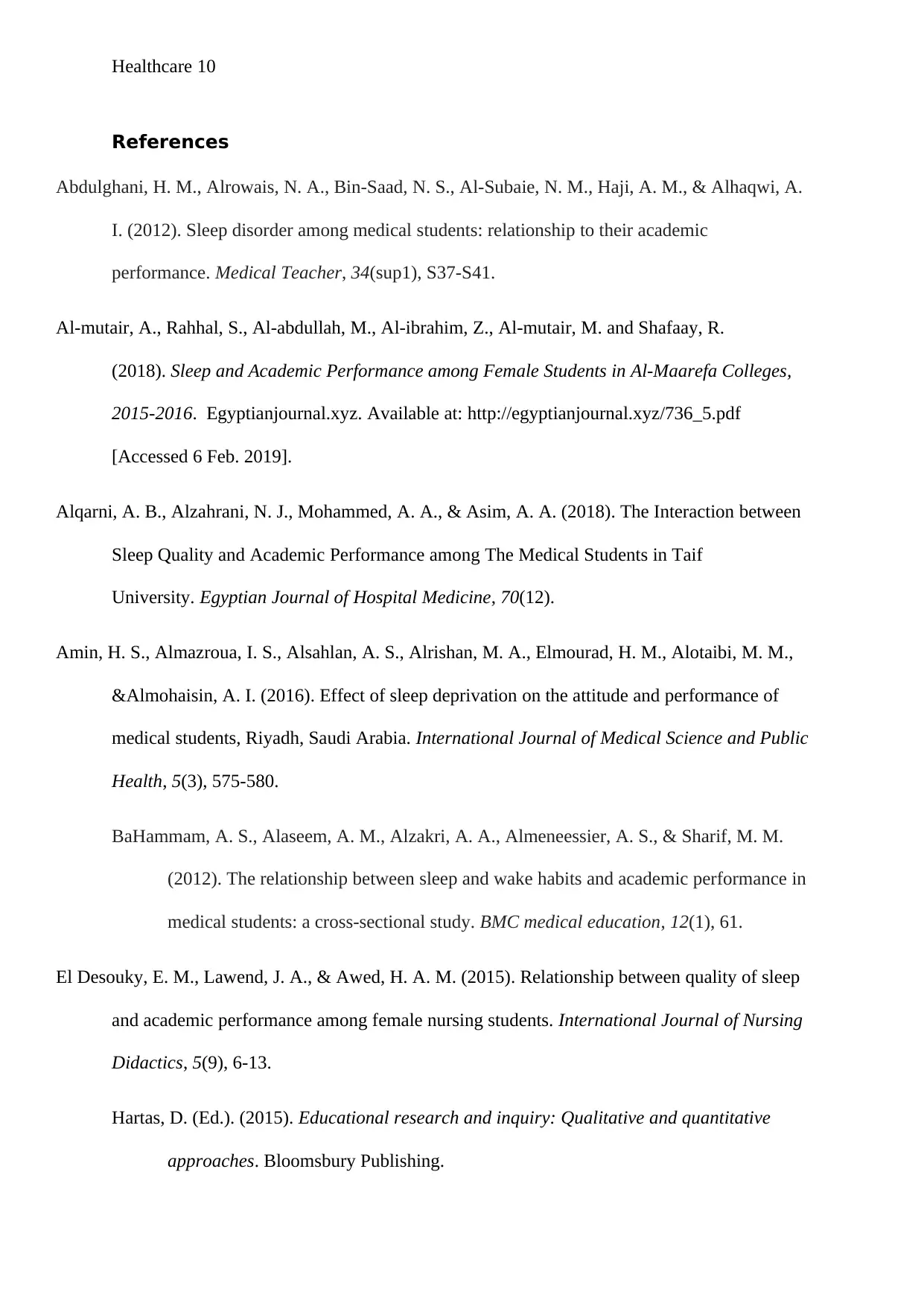
Healthcare 10
References
Abdulghani, H. M., Alrowais, N. A., Bin-Saad, N. S., Al-Subaie, N. M., Haji, A. M., & Alhaqwi, A.
I. (2012). Sleep disorder among medical students: relationship to their academic
performance. Medical Teacher, 34(sup1), S37-S41.
Al-mutair, A., Rahhal, S., Al-abdullah, M., Al-ibrahim, Z., Al-mutair, M. and Shafaay, R.
(2018). Sleep and Academic Performance among Female Students in Al-Maarefa Colleges,
2015-2016. Egyptianjournal.xyz. Available at: http://egyptianjournal.xyz/736_5.pdf
[Accessed 6 Feb. 2019].
Alqarni, A. B., Alzahrani, N. J., Mohammed, A. A., & Asim, A. A. (2018). The Interaction between
Sleep Quality and Academic Performance among The Medical Students in Taif
University. Egyptian Journal of Hospital Medicine, 70(12).
Amin, H. S., Almazroua, I. S., Alsahlan, A. S., Alrishan, M. A., Elmourad, H. M., Alotaibi, M. M.,
&Almohaisin, A. I. (2016). Effect of sleep deprivation on the attitude and performance of
medical students, Riyadh, Saudi Arabia. International Journal of Medical Science and Public
Health, 5(3), 575-580.
BaHammam, A. S., Alaseem, A. M., Alzakri, A. A., Almeneessier, A. S., & Sharif, M. M.
(2012). The relationship between sleep and wake habits and academic performance in
medical students: a cross-sectional study. BMC medical education, 12(1), 61.
El Desouky, E. M., Lawend, J. A., & Awed, H. A. M. (2015). Relationship between quality of sleep
and academic performance among female nursing students. International Journal of Nursing
Didactics, 5(9), 6-13.
Hartas, D. (Ed.). (2015). Educational research and inquiry: Qualitative and quantitative
approaches. Bloomsbury Publishing.
References
Abdulghani, H. M., Alrowais, N. A., Bin-Saad, N. S., Al-Subaie, N. M., Haji, A. M., & Alhaqwi, A.
I. (2012). Sleep disorder among medical students: relationship to their academic
performance. Medical Teacher, 34(sup1), S37-S41.
Al-mutair, A., Rahhal, S., Al-abdullah, M., Al-ibrahim, Z., Al-mutair, M. and Shafaay, R.
(2018). Sleep and Academic Performance among Female Students in Al-Maarefa Colleges,
2015-2016. Egyptianjournal.xyz. Available at: http://egyptianjournal.xyz/736_5.pdf
[Accessed 6 Feb. 2019].
Alqarni, A. B., Alzahrani, N. J., Mohammed, A. A., & Asim, A. A. (2018). The Interaction between
Sleep Quality and Academic Performance among The Medical Students in Taif
University. Egyptian Journal of Hospital Medicine, 70(12).
Amin, H. S., Almazroua, I. S., Alsahlan, A. S., Alrishan, M. A., Elmourad, H. M., Alotaibi, M. M.,
&Almohaisin, A. I. (2016). Effect of sleep deprivation on the attitude and performance of
medical students, Riyadh, Saudi Arabia. International Journal of Medical Science and Public
Health, 5(3), 575-580.
BaHammam, A. S., Alaseem, A. M., Alzakri, A. A., Almeneessier, A. S., & Sharif, M. M.
(2012). The relationship between sleep and wake habits and academic performance in
medical students: a cross-sectional study. BMC medical education, 12(1), 61.
El Desouky, E. M., Lawend, J. A., & Awed, H. A. M. (2015). Relationship between quality of sleep
and academic performance among female nursing students. International Journal of Nursing
Didactics, 5(9), 6-13.
Hartas, D. (Ed.). (2015). Educational research and inquiry: Qualitative and quantitative
approaches. Bloomsbury Publishing.
Paraphrase This Document
Need a fresh take? Get an instant paraphrase of this document with our AI Paraphraser
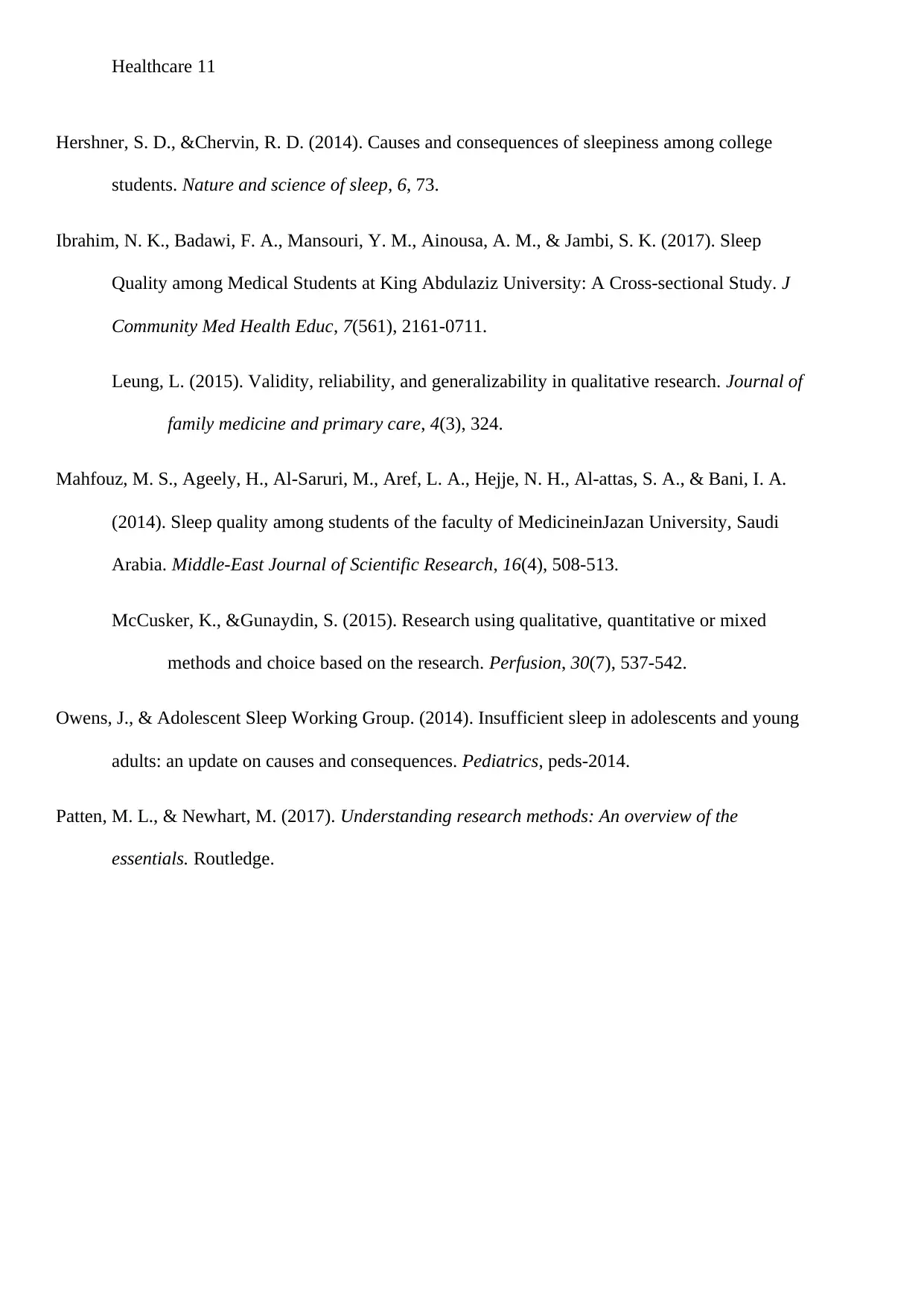
Healthcare 11
Hershner, S. D., &Chervin, R. D. (2014). Causes and consequences of sleepiness among college
students. Nature and science of sleep, 6, 73.
Ibrahim, N. K., Badawi, F. A., Mansouri, Y. M., Ainousa, A. M., & Jambi, S. K. (2017). Sleep
Quality among Medical Students at King Abdulaziz University: A Cross-sectional Study. J
Community Med Health Educ, 7(561), 2161-0711.
Leung, L. (2015). Validity, reliability, and generalizability in qualitative research. Journal of
family medicine and primary care, 4(3), 324.
Mahfouz, M. S., Ageely, H., Al-Saruri, M., Aref, L. A., Hejje, N. H., Al-attas, S. A., & Bani, I. A.
(2014). Sleep quality among students of the faculty of MedicineinJazan University, Saudi
Arabia. Middle-East Journal of Scientific Research, 16(4), 508-513.
McCusker, K., &Gunaydin, S. (2015). Research using qualitative, quantitative or mixed
methods and choice based on the research. Perfusion, 30(7), 537-542.
Owens, J., & Adolescent Sleep Working Group. (2014). Insufficient sleep in adolescents and young
adults: an update on causes and consequences. Pediatrics, peds-2014.
Patten, M. L., & Newhart, M. (2017). Understanding research methods: An overview of the
essentials. Routledge.
Hershner, S. D., &Chervin, R. D. (2014). Causes and consequences of sleepiness among college
students. Nature and science of sleep, 6, 73.
Ibrahim, N. K., Badawi, F. A., Mansouri, Y. M., Ainousa, A. M., & Jambi, S. K. (2017). Sleep
Quality among Medical Students at King Abdulaziz University: A Cross-sectional Study. J
Community Med Health Educ, 7(561), 2161-0711.
Leung, L. (2015). Validity, reliability, and generalizability in qualitative research. Journal of
family medicine and primary care, 4(3), 324.
Mahfouz, M. S., Ageely, H., Al-Saruri, M., Aref, L. A., Hejje, N. H., Al-attas, S. A., & Bani, I. A.
(2014). Sleep quality among students of the faculty of MedicineinJazan University, Saudi
Arabia. Middle-East Journal of Scientific Research, 16(4), 508-513.
McCusker, K., &Gunaydin, S. (2015). Research using qualitative, quantitative or mixed
methods and choice based on the research. Perfusion, 30(7), 537-542.
Owens, J., & Adolescent Sleep Working Group. (2014). Insufficient sleep in adolescents and young
adults: an update on causes and consequences. Pediatrics, peds-2014.
Patten, M. L., & Newhart, M. (2017). Understanding research methods: An overview of the
essentials. Routledge.

Healthcare 12
Questionnaire
Being a student of Saudi Electronic University, the following questions I
will ask to the participants in the interview round which is the main
method of the research. The following questions will be about the sleeping
patterns of the students who will be the participants. Please, fill out the
following questionnaire whichever is applicable for you.
1. Do you have a habit of sleeping early?
Yes
No
2. Do you sleep at day time?
Yes
No
3. Do you suffer from sleeplessness at bed?
Yes
No
4. Do you have a habit of taking alcohol before bed-time?
Yes
No
5. Do sleepless night affects the next day?
Yes
No
6. When do you sleep at night?
10-12
12-2
2-4
7. How long do you sleep in day time?
1-2 hours
2-3 hours
More
Questionnaire
Being a student of Saudi Electronic University, the following questions I
will ask to the participants in the interview round which is the main
method of the research. The following questions will be about the sleeping
patterns of the students who will be the participants. Please, fill out the
following questionnaire whichever is applicable for you.
1. Do you have a habit of sleeping early?
Yes
No
2. Do you sleep at day time?
Yes
No
3. Do you suffer from sleeplessness at bed?
Yes
No
4. Do you have a habit of taking alcohol before bed-time?
Yes
No
5. Do sleepless night affects the next day?
Yes
No
6. When do you sleep at night?
10-12
12-2
2-4
7. How long do you sleep in day time?
1-2 hours
2-3 hours
More
⊘ This is a preview!⊘
Do you want full access?
Subscribe today to unlock all pages.

Trusted by 1+ million students worldwide
1 out of 14
Related Documents
Your All-in-One AI-Powered Toolkit for Academic Success.
+13062052269
info@desklib.com
Available 24*7 on WhatsApp / Email
![[object Object]](/_next/static/media/star-bottom.7253800d.svg)
Unlock your academic potential
Copyright © 2020–2025 A2Z Services. All Rights Reserved. Developed and managed by ZUCOL.




